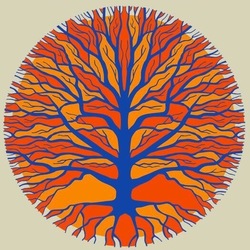Rootstock Cellars
R. López de Heredia
Viña Tondonia Reserva Rioja Tempranillo Blend 2006
With the Wine Blight laying waste to her vineyards, France went from 8:1 exporter in 1870 to 6:1 importer in 1887. Legions of wine farmers faced total financial ruin. With no cure - or even a proper diagnosis - in sight, many saw no option but to flee to lands not yet affected.
The influx of institutional knowledge that flooded into former backwater wine regions like Rioja catapulted them into relevance, and soon matured into a world-class standard. The farmers had found respite, but couldn't run forever. By the time Phylloxera crossed the Pyrenees, however, there would be new ways to fight back.
French botanist Jules-Emile Planchon had a theory. If the blight was caused by a microscopic American insect as he suspected, perhaps grafted European varieties on American rootstock would be resistant. This would be confirmed by Missouri entomologist Charles Riley, and with millions of rootstocks supplied by Texas horticulturalist T.V. Munson, the Wine Blight was soon in remission.
(This is adapted from notes for Le Dû’s Wines ‘History of Wine 1453AD-Present’ seminar, where this wine was poured) — 5 years ago
Pierre-Yves Colin-Morey
Bourgogne Chardonnay 2018
Stupid at under $40. Buy all you can.
Green & Golden apple, banana, lemon & lime candy, cream, super soft chalkiness, vanillin, fruit blossoms, spring flowers, jasmine caramel notes, honeysuckle to understated honey, with yellow florals, spring flowers with mixed greens. If you are an acid head (like me) it’s perfect. Excellent long finish that is well balanced, elegant, polished and sings persistently for minutes ending in mid white spice.
Photos of; one of their Grand Cru vineyards, likely 40-50 year plus rootstock, Pierre-Yves Colin and library cellar. — 4 years ago

Daou Vineyards
Pessimist Paso Robles Red Blend 2017
This is ridiculously fruity and jammy yet dark and tannic, 🍷delicious drink now, not serious. Happy Saturday, Cheers! @Rootstock Los Gatos — 4 years ago
Château Poujeaux
Moulis en Médoc Red Bordeaux Blend 2007
First, let me say the 07 Bordeaux vintage was largely frowned upon by professional critics. When I tasted it upon release, I had some doubts. However, I have said many times, in all difficult vintages anywhere, there are still producers that made good wine. Especially, if you give them time to evolve in bottle. This 07 has blossomed with 10 years in bottle and an absolutely perfect steak wine.
The nose reveals; smoldering ambers, dry crushed rocks, limestone minerals, ripe blackberries, black cherries, black raspberries, baked strawberries, black plum, floral blueberries, dark fruit liqueur, leather, cedar to saddle-wood, dark rich soils, stones, anise, graphite, old cigar with ash, hints of mushroom, steeped tea, fresh & withering red & dark floral bouquet.
The body is beautiful with; rich, round, velvety, smooth, tarry tannins. This 07 Poujeaux is in top form with plenty of life left ahead...another 7-10years easily. The structure, tension, length and balance are nicely knitted together. It glides effortlessly over the palate. A combination of dark currants & cassis. Ripe blackberries, black cherries, black raspberries, bright cherries, baked strawberries, black plum, floral blueberries, dark fruit liqueur, dark chocolate, mocha bar, vanilla, clove, dark spice, leather, cedar to saddle-wood, dark rich soils, stones, smoldering ambers, dry crushed rocks, dry clay, limestone minerals, dry brush, anise, graphite, old cigar with ash, touch of pepper, hints of mushroom, steeped tea, beautifully, fragrant, violets, lavender, fresh & withering red & dark floral bouquet. The acidity is nicely balanced in the wine. The finish without the steak shows dusty, grainy tannins, good balance in fruit & earth, elegant, ripe fruit and persistent on the palate.
Photos of, the unassuming Chateau Poujeaux by Bordeaux standards, the rootstock & soil structure of the Poujeaux terroir, Cellar with concrete tanks & large oak vats and a wide shot of the Estate.
Producer history and notes...Chateau Poujeaux’s history can be traced back to the 16th Century. At that time, the owner of Chateau Latour, Gaston De L’Isle, owned the estate. Over the centuries, Chateau Poujeaux, like numerous Bordeaux estates has been the property of a multitude of owners.
In fact, the owner of Chateau Beychevelle Marquis François Etienne de Brassier was one of owners. Over the centuries, Chateau Poujeaux was bought, sold, split up and divided. It was not until 1921, when the Theil family became the owners of the property that all the previously divided sections were brought back together again.
The modern era for Chateau Poujeaux began more recently. It started in 2008, when Jean Theil sold Chateau Poujeaux to the Cuvelier family, who were already owners of Clos Fourtet in St. Emilion. Once the Cuvelier family purchased, Mathieu Cuvelier took charge and things changed for the better.
The winemaking facilities were modernized and the farming technique used in the vineyards of Chateau Poujeaux were also changed.
They reduced yields and began picking later, giving them riper fruit. They also moved to an organic vineyard management approach and are looking at biodynamic farming as well. All of this work in the vineyards have helped push the wine quality of the estate. You only need to open and taste some their newer vintages. You’ll notice the improvement in fruit quality and the winemaking practices.
The 68 hectare Moulis vineyard of Chateau Poujeaux is planted to 50% Cabernet Sauvignon, 40% Merlot, 5% Cabernet Franc and 5% Petit Verdot. The terroir is gravel based soils, typical of the area as show in the above photo. The average age of the vines is close to 35 years, although some vines are older.
The debut vintage under the Cuvelier family was the 2008. At Chateau Poujeaux, they are practicing serious vineyard management with the help of Stéphane Derenoncourt, who works with numerous Bordeaux Winemakers on both banks, including the Cuvelier’s property in St. Emilion, Clos Fourtet.
Chateau Poujeaux, fruit is whole berry fermented in a combination of small stainless steel vats, oak barrels and cement tanks with a 25-day cuvaison. Chateau Poujeaux is aged in about 40% new, French oak barrels for an average of 12 months. On average, Chateau Poujeaux produces close to 25,000 cases per year. — 5 years ago


Bohème Wines
English Hill Vineyard Sonoma Coast Pinot Noir 2016
medium reddish purple, translucent core, amber rim; red cherry, raspberry, mushrooms, pine needles; red fruit, slightly spicy finish; medium body, good acidity, light tannins which are fine grained, 13.5% ABV; made from 100% Pinot Noir sourced from vineyard Kurt Beiler planted rootstock in 2004 and grafted 2006 with multiple clones, site is in both the Sonoma Coast and Russian River Valley AVA’s and is the warmest of his 3 vineyard sites; about 30% whole clusters were used, aged 18 months in 20% new French oak; $55 — 4 years ago
Emmolo Winery
Napa Valley Merlot 2017
In 1923 Salvatore Emmolo immigrated from Sicily to Napa buying property and starting grapevine rootstock. Salvatore’s granddaughter Cheryl started the Emmolo label in 1994, now run by Jenny Wagner, Cheryl’s daughter. Grapes sourced from Napa Valley’s Oak Knoll district, deep Ruby with purple edges and aromas of black fruits, some oak and sweet spice. The palate yielded berry jam and fruit tastes with a touch of roasted espresso beans and a perfect amount of pungent, almost smoky spice, to a clean light oak and nutty finish on smooth, slightly gripping tannins. A real Gem! Tasting Sample! — 4 years ago
Lioco
Demuth Vineyard Chardonnay 2014
This is such a dynamic site. 1600ft above the valley floor, Wente clone on AXR-1 rootstock planted in 1982. This has white Burgundy nods written all over it in opening it tonight on 6/20/2019. Cheers John & Kai!
This is delish and the remaining bottles that capture this vineyard’s site expression still out there in the wild are worth celebrating. — 5 years ago










JKT
A rich but now well balanced Zin in that ripe style that I’d likely not have been too fond of when it was younger. Bottle coated with sediment and oak is prominent in how it’s resolved with plummy berry vanilla notes. Back label says a field blend of Zin Carignane and Petit Sirah, Alexander Valley vineyard, vines cultivated on St. George rootstock grafted onto a 75 year old clone of Zin. — 3 years ago